|

 Up Up

 The 1900 The 1900
Wright Glider 
(You
are here.)
  
  Need
to Need
to
find
your
bearings?
Try
these
navigation
aids:
If
this is your first
visit, please
stop by:
Something to share?
Please:
  
|
|
 he 1900 Wright Glider was a revolution in aeronautical
engineering. It was the first of its kind with
aerodynamic control surfaces – movable planes to help
balance the glider in the air. The front elevator could be curved to
pitch the nose of the aircraft up or down. The wings could be
twisted or "warped" to roll the aircraft right and left. The
pioneer glider pilots that preceded the Wright brothers had simply
shifted their weight to balance their craft – a difficult,
dangerous, and ineffective method of control. he 1900 Wright Glider was a revolution in aeronautical
engineering. It was the first of its kind with
aerodynamic control surfaces – movable planes to help
balance the glider in the air. The front elevator could be curved to
pitch the nose of the aircraft up or down. The wings could be
twisted or "warped" to roll the aircraft right and left. The
pioneer glider pilots that preceded the Wright brothers had simply
shifted their weight to balance their craft – a difficult,
dangerous, and ineffective method of control.
There were other innovations as well. The Wrights used
considerably less rigging to brace their airframe than previous
glider makers such as Pilcher, Chanute, and Lilienthal. This reduced
drag considerably. For that same reason, the pilot lay in a prone
position rather than hanging beneath the glider. Orville had done
some bicycle racing, and the brothers were well aware of what a
difference could be made in performance by reducing the profile of
the operator in the wind.
Unfortunately, despite their measures to reduce
drag, the performance was disappointing. The Wrights' first glider
did not produce the expected lift. Only in high winds – too high to
fly safely – would it carry a grown man. Consequently, they flew it
mostly as an unmanned kite. But it was a success in one respect. The
control surfaces worked well. Manipulating the controls from the
ground with cables, the brothers could pitch and roll the aircraft
with authority. Just before they left Kitty Hawk to return home to
Dayton, Wilbur mounted the glider for several manned glides, some of
which covered over 200 feet. Encouraged by the success of their
controls and thrilled by their first real flights, they began to
build a series of gliders and airplanes, each one better than the
last. This work eventually resulted in the first practical
aircraft.
To celebrate the 100th anniversary of these first
tentative flights, the Wright Brothers Aeroplane Company built a
replica of the 1900 Glider, then flew it at Kitty Hawk on October
22, 2000 -- precisely a century after the Wrights made their first
flights.
|
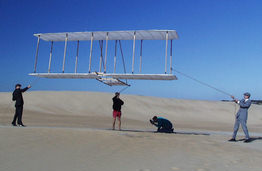
Kiting the 1901 Wright Glider for the PBS film,
Kitty Hawk: A Journey of
Invention.
|
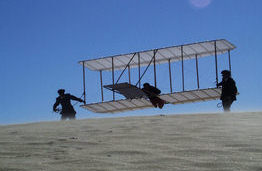
Launching the 1900 Wright Glider for
Kitty Hawk: A Journey of
Invention.
|

Shades of Tom Tate. Like the Wright
brothers, we kited a young person aloft in the 1900 glider. Tom must
have enjoyed his ride at least as much as this young lady.
|
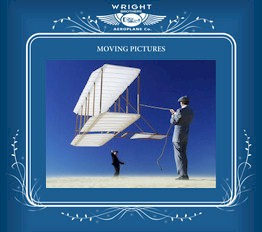
If you like to see some flight tests of our 1900
Wright Glider replica, click HERE.
|
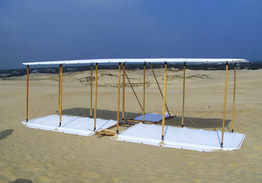
The 1900 Glider replica as it looks from the rear. Like all
early Wright aircraft, the elevator is in front. This aircraft had a
tail at first, but Wilbur removed it when he was sure the controls
worked properly.
|
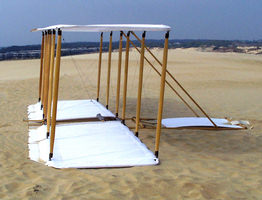
The glider from the right side -- note that the rear spar is
on top of the ribs instead of under them. Early on, the Wrights
thought that lift was produced underneath the wings and that it was
more important to keep the underside of the wing
smooth.
|
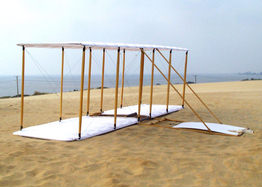
The glider diagonally from the right side. They were wrong,
of course -- about keeping the bottom of the wings smooth, that is.
In its position on top of the spar, the rear spar acts as a spoiler
and reduces the lift.
|
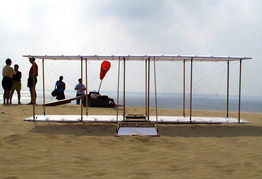
The glider straight on. Although the rigging was based on
a standard "Pratt Truss," it was a system the Wrights had invented.
By tensioning just four wires on the airplane, they could tune all
the flying and landing wires.
|
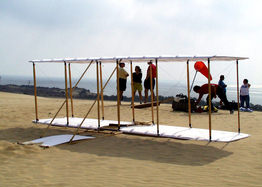
A diagonal view from the left front. That's Kitty Hawk Bay
behind the glider.
|
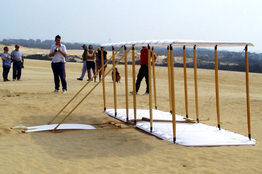
And finally, the left side. The big lump at the front of
the elevator is a 25-pound bag of lead shot to keep the wind from
snatching the glider.
|
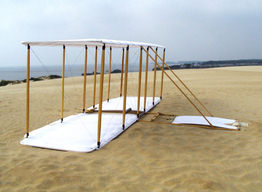
Click on the photo to download a video
that allows you to "spin" the glider so you can see it from all
sides. You must have a "Quicktime" plug-in.
|
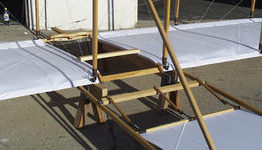
The glider cockpit -- you lay down with your weight
supported on the front spar and the "belly bar." It is the most
uncomfortable cockpit you can imagine. The Wrights were dynamite at
engineering, but sadly lacking in ergonomics.
|
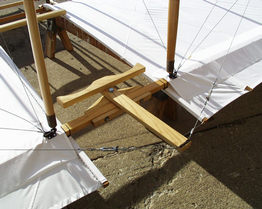
The kickbar – by pressing the top of the "T" with one foot
or the other, you actuate the wing warping. Kick right to roll the
aircraft left left to roll it right.
|

The elevator controls are backwards as
well. Twist the control bar up to go down and down to go
up.
|

The frame of the 1900 Wright Glider
before we covered the wings and elevator.
|
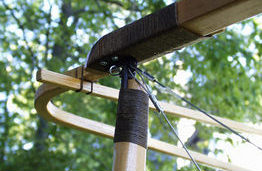
The frames of all the Wrights gliders
were lashed together with waxed linen cord, the "duct tape" of the
Victorian era. This is the rear left corner of the upper
wing.
|
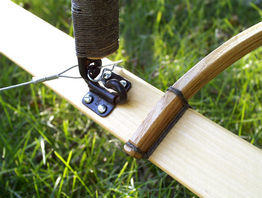
A front rib and strut attachment. The
front spar was cut to a triangular shape.
|

1900 Wright Glider rigging and control
wires.
|
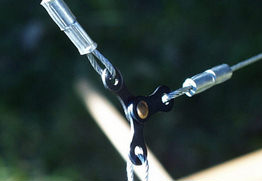
We made the three-way pivot for the
swing wires from three bicycle chain links.
|
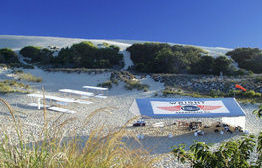
Our camp at Jockey's Ridge State Park, North
Carolina, with all three gliders outside our hangar/tent.
|
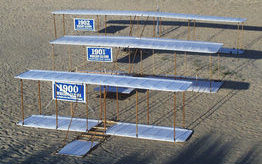
The 1900, 1901, and 1903 Wright gliders
from the front.
|
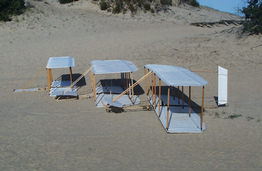
The gliders from the side.
|
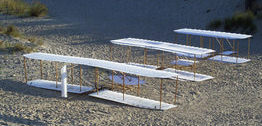
And from the rear. We made this line-up
to compare the gliders and see first-hand the evolution of the
Wright brothers' aeronautical science and engineering.
|
|
|
























